RENAULT FLUENCE 2012 1.G Owners Manual
Manufacturer: RENAULT, Model Year: 2012, Model line: FLUENCE, Model: RENAULT FLUENCE 2012 1.GPages: 241, PDF Size: 6.5 MB
Page 151 of 241
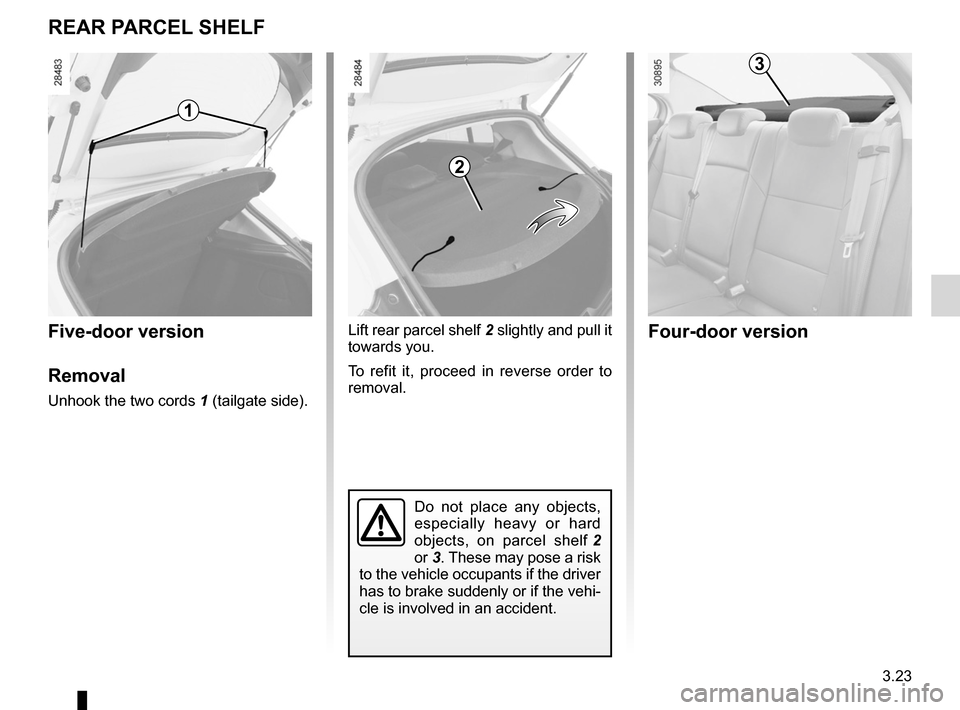
rear parcel shelf .................................... (up to the end of the DU)
tailgate .................................................. (up to the end of the DU)
rear parcel shelf .................................... (up to the end of the DU)
3.23
ENG_UD21357_2
Tablette arrière (L38 - X38 - Renault)
ENG_NU_891_892-7_L38-B32_Renault_3
Lift rear parcel shelf 2 slightly and pull it
towards you.
To refit it, proceed in reverse order to
removal.Five-door version
Removal
Unhook the two cords 1 (tailgate side).
Rear parcel shelf
Do not place any objects,
especially heavy or hard
objects, on parcel shelf 2
or 3. These may pose a risk
to the vehicle occupants if the driver
has to brake suddenly or if the vehi-
cle is involved in an accident.
REAR PARcEl ShElF
1
Four-door version
2
3
Page 152 of 241
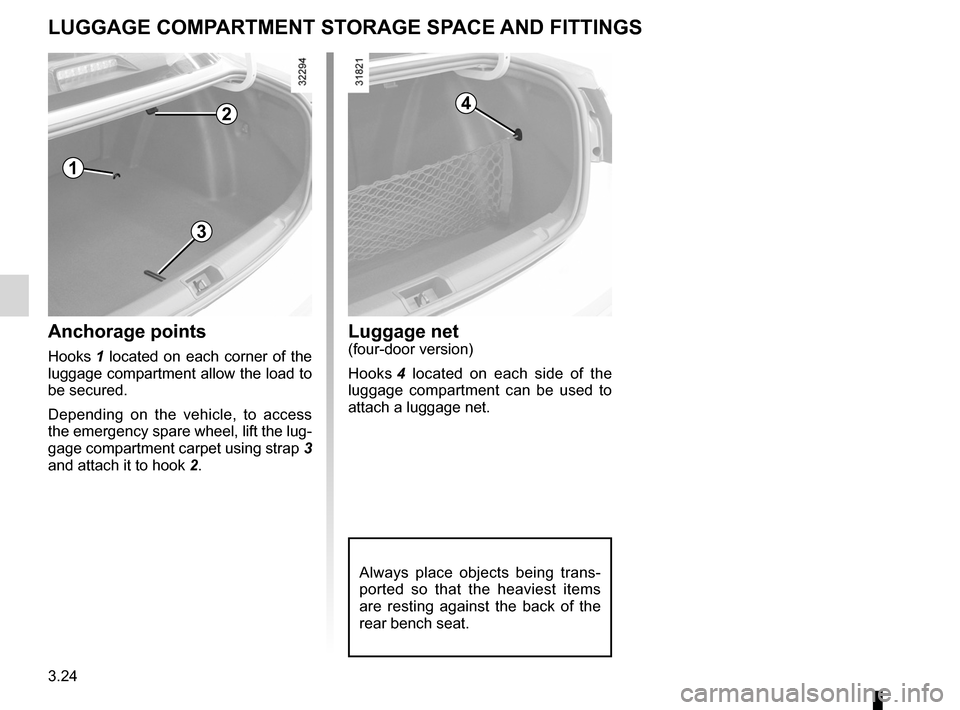
storage compartments .......................... (up to the end of the DU)
tailgate .................................................. (up to the end of the DU)
3.24
ENG_UD21628_2
Rangements / aménagements coffre à bagage (L38 - X38 - Renault)
ENG_NU_891_892-7_L38-B32_Renault_3
Luggage compartment storage space and fittings
luggAgE coMPARTMENT ST oRAgE SPAcE AND FITTINgS
2
Anchorage points
Hooks 1 located on each corner of the
luggage compartment allow the load to
be secured.
Depending on the vehicle, to access
the emergency spare wheel, lift the lug-
gage compartment carpet using strap 3
and attach it to hook 2.
Always place objects being trans -
ported so that the heaviest items
are resting against the back of the
rear bench seat.
luggage net(four-door version)
Hooks 4 located on each side of the
luggage compartment can be used to
attach a luggage net.
4
1
3
Page 153 of 241
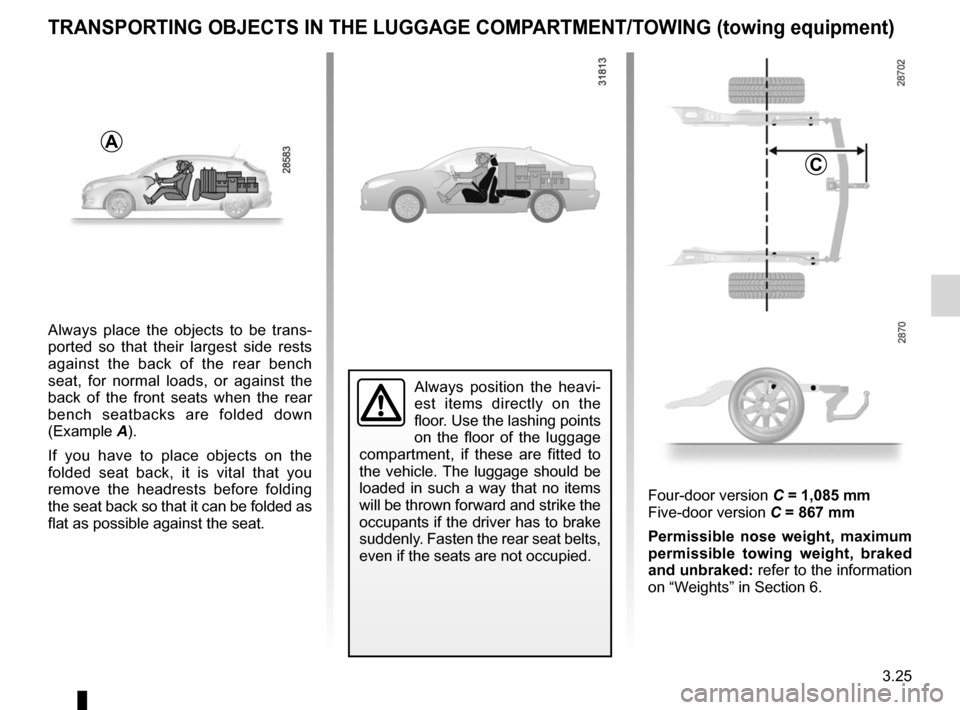
transporting objectsin the luggage compartment ........... (up to the end of the DU)
towing rings .......................................... (up to the end of the DU)
towing towing equipment ............................ (up to the end of the DU)
towing equipment fitting ............................................... (up to the end of the DU)
towing a caravan .................................. (up to the end of the DU)
3.25
ENG_UD21629_3
Transport d’objets dans le coffre (L38 - X38 - Renault)
ENG_NU_891_892-7_L38-B32_Renault_3
Transporting objects in the luggage compartment/Towing (towing equipment)
TRANSPoRTINg oBjEcTS IN ThE luggAgE coMPARTMENT/TowINg (towing equipment)
A
Always position the heavi -
est items directly on the
floor. Use the lashing points
on the floor of the luggage
compartment, if these are fitted to
the vehicle. The luggage should be
loaded in such a way that no items
will be thrown forward and strike the
occupants if the driver has to brake
suddenly. Fasten the rear seat belts,
even if the seats are not occupied.
c
Always place the objects to be trans -
ported so that their largest side rests
against the back of the rear bench
seat, for normal loads, or against the
back of the front seats when the rear
bench seatbacks are folded down
(Example A).
If you have to place objects on the
folded seat back, it is vital that you
remove the headrests before folding
the seat back so that it can be folded as
flat as possible against the seat. Four-door version
C = 1,085 mm
Five-door version C = 867 mm
Permissible nose weight, maximum
permissible towing weight, braked
and unbraked: refer to the information
on “Weights” in Section 6.
Page 154 of 241
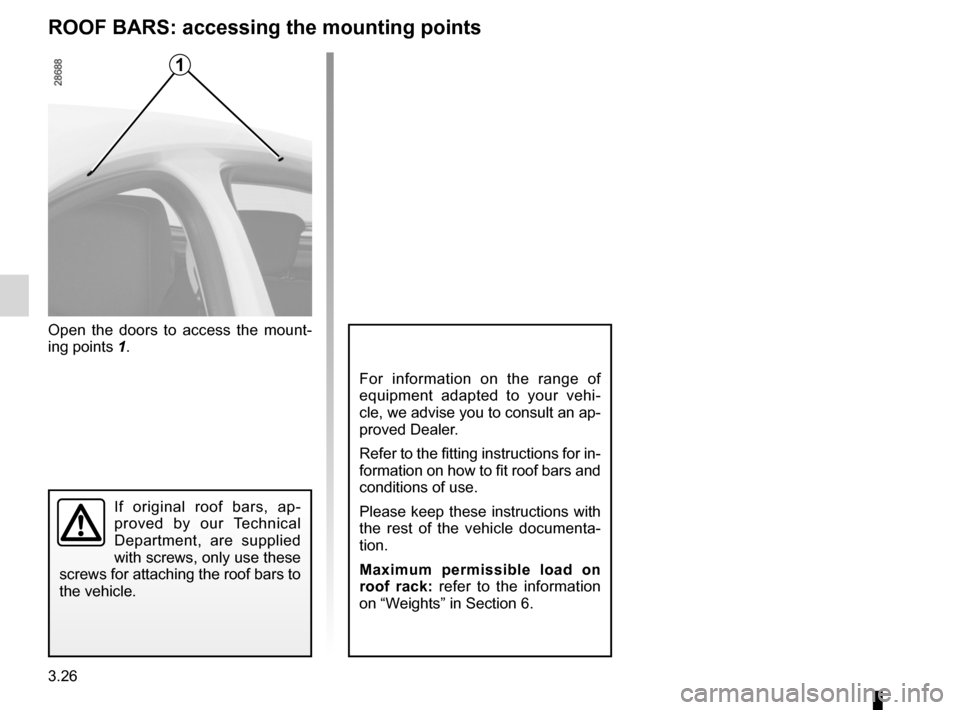
roof bars ............................................... (up to the end of the DU)
roof rack roof bars .......................................... (up to the end of the DU)
3.26
ENG_UD13679_1
Barres de toit (L38 - X38 - Renault)
ENG_NU_891_892-7_L38-B32_Renault_3
Roof bars
RooF BARS: accessing the mounting points
Open the doors to access the mount -
ing points 1.
For information on the range of
equipment adapted to your vehi -
cle, we advise you to consult an ap-
proved Dealer.
Refer to the fitting instructions for in-
formation on how to fit roof bars and
conditions of use.
Please keep these instructions with
the rest of the vehicle documenta -
tion.
Maximum permissible load on
roof rack: refer to the information
on “Weights” in Section 6.
If original roof bars, ap -
proved by our Technical
Department, are supplied
with screws, only use these
screws for attaching the roof bars to
the vehicle.
1
Page 155 of 241

multimedia equipment .......................... (up to the end of the DU)
telephone .............................................. (up to the end of the DU)
navigation system ................................. (up to the end of the DU)
hands-free telephone integrated control
(up to the end of the DU)
navigation ............................................. (up to the end of the DU)
radio...................................................... (up to the end of the DU)
3.27
ENG_UD21630_2
Equipement Multimédia (L38 - X38 - Renault)
ENG_NU_891_892-7_L38-B32_Renault_3
Multimedia equipment
Mul TIMEDIA EquIPMENT
The presence and location of this
equipment depends on the vehicle’s
multimedia equipment.
1 Radio;
2 Display;
3 Steering column control;
4 Microphone.
hands-free telephone
integrated control
On equipped vehicles, use micro -
phone 4 and steering column control 3.
To use this equipment, consult the
instructions for the equipment which
should be kept with the other vehi -
cle documentation.
1
4
3
using the telephone
We remind you of the need
to conform to the legislation
in force concerning the use
of such equipment.
2
Page 156 of 241
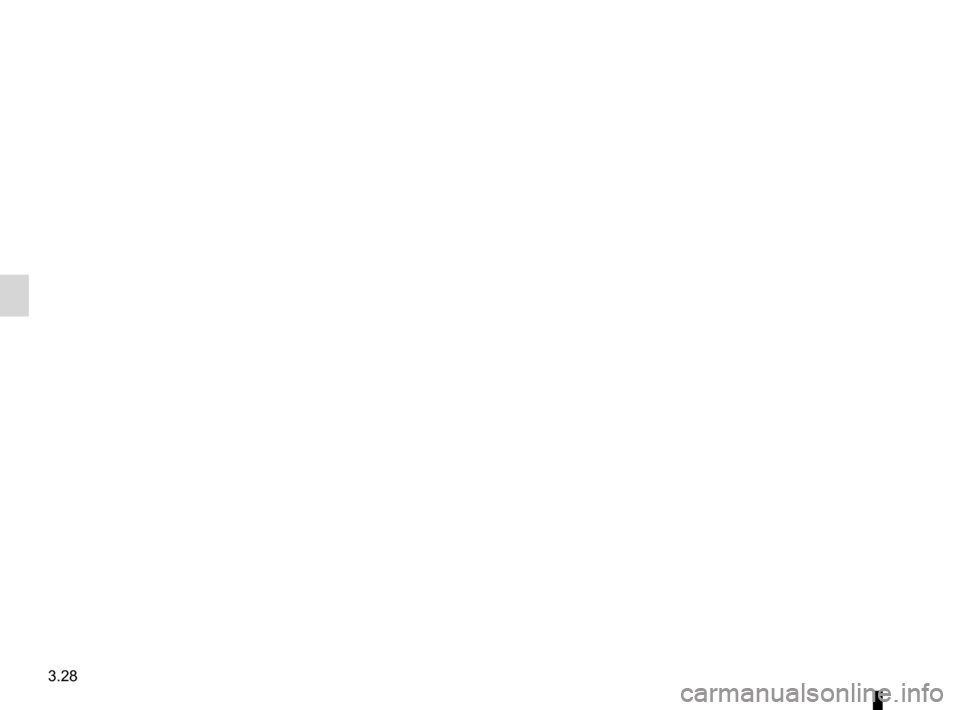
3.28
ENG_UD20783_6
Filler NU (X06 - C06 - S06 - X35 - L35 - X44 - C44 - G44 - X45 - H45 - X65 - L65 - S65 - X73 - B73 - X74 - B74 - K74 - X77 - J77 - F77 - R77 - X81 - J81 - X84 - B84 - C84
ENG_NU_891_892-7_L38-B32_Renault_3
Page 157 of 241
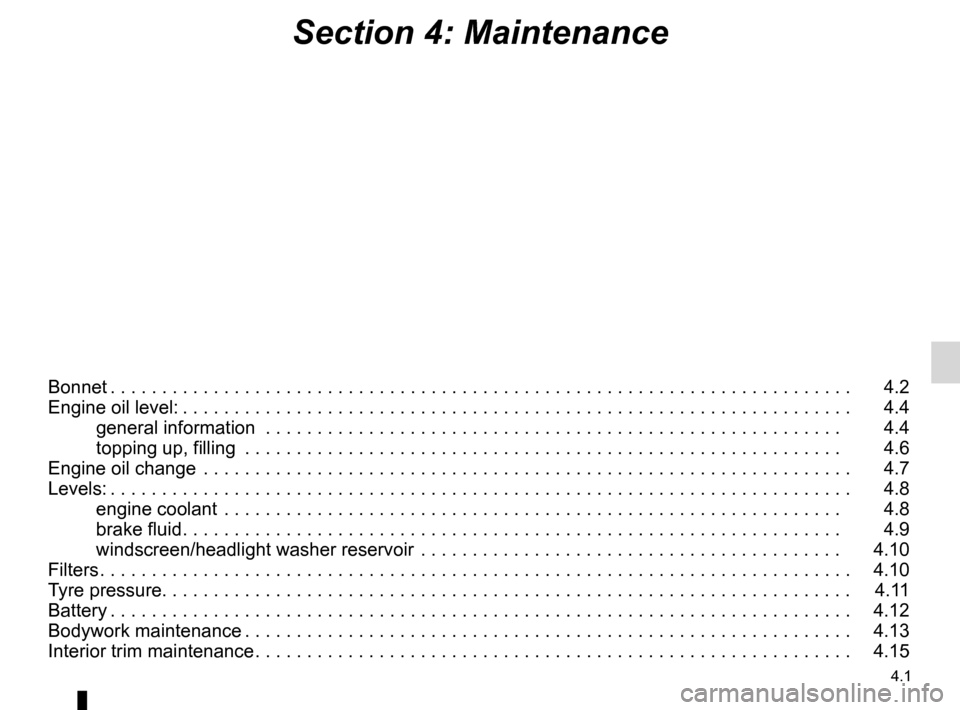
4.1
ENG_UD27183_7
Sommaire 4 (L38 - X38 - Renault)
ENG_NU_891_892-7_L38-B32_Renault_4
Section 4: Maintenance
Bonnet . . . . . . . . . . . . . . . . . . . . . . . . . . . . . . . . . . . . . . . . . . . . . . . . . . . . . . . . . . . . . . . . . . . . . . . . 4.2
Engine oil level: . . . . . . . . . . . . . . . . . . . . . . . . . . . . . . . . . . . . . . . . . . . . . . . . . . . . . . . . . . . . . . . . . 4.4
general information . . . . . . . . . . . . . . . . . . . . . . . . . . . . . . . . . . . . . . . . . . . . . . . . . . . . . . . . 4.4
topping up, filling . . . . . . . . . . . . . . . . . . . . . . . . . . . . . . . . . . . . . . . . . . . . . . . . . . . . . . . . . . 4.6
Engine oil change . . . . . . . . . . . . . . . . . . . . . . . . . . . . . . . . . . . . . . . . . . . . . . . . . . . . . . . . . . . . . . . 4.7
Levels: . . . . . . . . . . . . . . . . . . . . . . . . . . . . . . . . . . . . . . . . . . . . . . . . . . . . . . . . . . . . . . . . . . . . . . . . 4.8
engine coolant . . . . . . . . . . . . . . . . . . . . . . . . . . . . . . . . . . . . . . . . . . . . . . . . . . . . . . . . . . . . 4.8
brake fluid . . . . . . . . . . . . . . . . . . . . . . . . . . . . . . . . . . . . . . . . . . . . . . . . . . . . . . . . . . . . . . . . 4.9
windscreen/headlight washer reservoir . . . . . . . . . . . . . . . . . . . . . . . . . . . . . . . . . . . . . . . . . 4.10
Filters . . . . . . . . . . . . . . . . . . . . . . . . . . . . . . . . . . . . . . . . . . . . . . . . . . . . . . . . . . . . . . . . . . . . . . . . . 4.10
Tyre pressure. . . . . . . . . . . . . . . . . . . . . . . . . . . . . . . . . . . . \
. . . . . . . . . . . . . . . . . . . . . . . . . . . . . . . 4.11
Battery . . . . . . . . . . . . . . . . . . . . . . . . . . . . . . . . . . . . . . . . . . . . . . . . . . . . . . . . . . . . . . . . . . . . . . . . 4.12
Bodywork maintenance . . . . . . . . . . . . . . . . . . . . . . . . . . . . . . . . . . . . . . . . . . . . . . . . . . . . . . . . . . . 4.13
Interior trim maintenance . . . . . . . . . . . . . . . . . . . . . . . . . . . . . . . . . . . . . . . . . . . . . . . . . . . . . . . . . . 4.15
Page 158 of 241
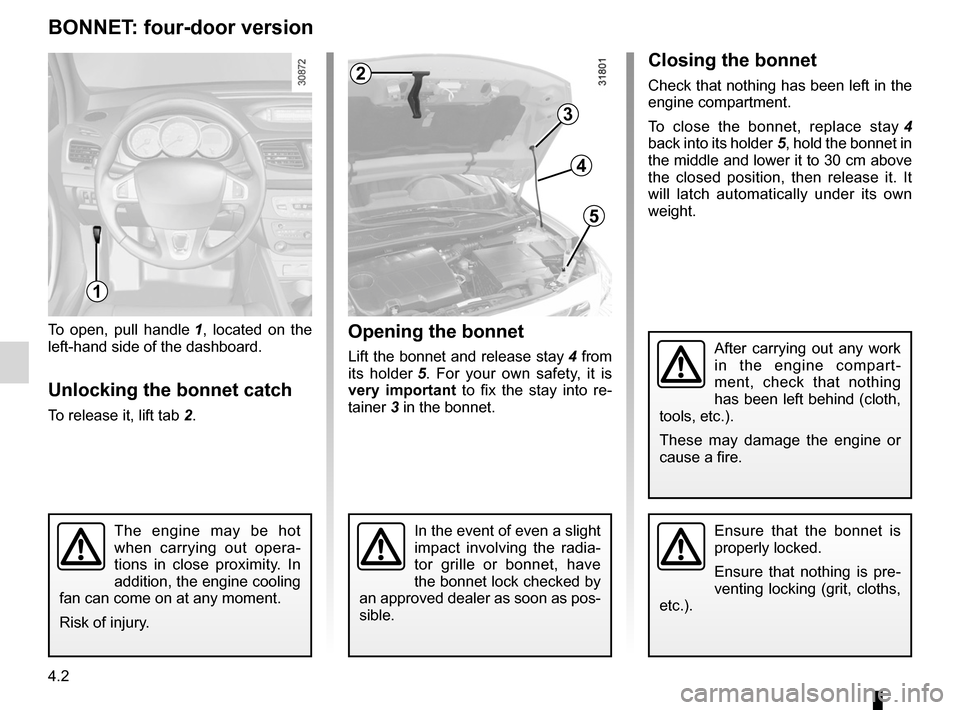
bonnet................................................... (up to the end of the DU)
maintenance: mechanical ...................................... (up to the end of the DU)
4.2
ENG_UD23759_3
Capot moteur (L38 - X38 - Renault)
ENG_NU_891_892-7_L38-B32_Renault_4
Jaune NoirNoir texte
Bonnet
Opening the bonnet
Lift the bonnet and release stay 4 from
its holder 5 . For your own safety, it is
very important to fix the stay into re -
tainer 3 in the bonnet.
To open, pull handle
1 , located on the
left-hand side of the dashboard.
Unlocking the bonnet catch
To release it, lift tab 2.
BOnnet: four-door version
1
2Closing the bonnet
Check that nothing has been left in the
engine compartment.
To close the bonnet, replace stay 4
back into its holder 5, hold the bonnet in
the middle and lower it to 30 cm above
the closed position, then release it. It
will latch automatically under its own
weight.
Ensure that the bonnet is
properly locked.
Ensure that nothing is pre -
venting locking (grit, cloths,
etc.).The engine may be hot
when carrying out opera -
tions in close proximity. In
addition, the engine cooling
fan can come on at any moment.
Risk of injury.In the event of even a slight
impact involving the radia -
tor grille or bonnet, have
the bonnet lock checked by
an approved dealer as soon as pos-
sible.
3
4
5
After carrying out any work
in the engine compart -
ment, check that nothing
has been left behind (cloth,
tools, etc.).
These may damage the engine or
cause a fire.
Page 159 of 241
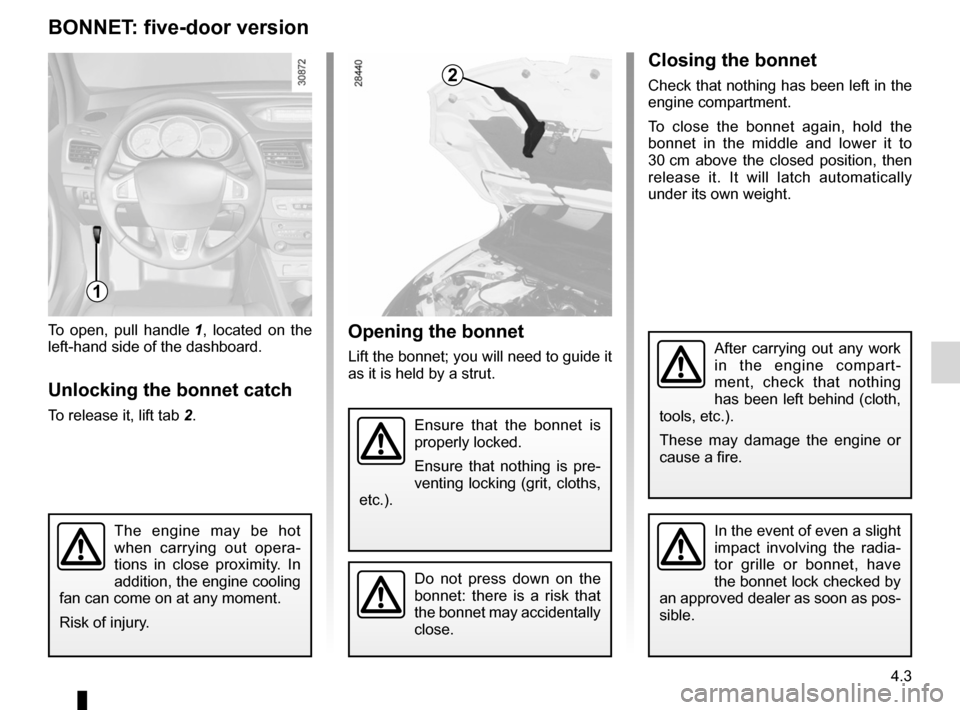
JauneNoirNoir texte
4.3
ENG_UD23759_3
Capot moteur (L38 - X38 - Renault)
ENG_NU_891_892-7_L38-B32_Renault_4
Opening the bonnet
Lift the bonnet; you will need to guide it
as it is held by a strut.
To open, pull handle
1 , located on the
left-hand side of the dashboard.
Unlocking the bonnet catch
To release it, lift tab 2.
BOnnet: five-door version
2Closing the bonnet
Check that nothing has been left in the
engine compartment.
To close the bonnet again, hold the
bonnet in the middle and lower it to
30 cm above the closed position, then
release it. It will latch automatically
under its own weight.
Ensure that the bonnet is
properly locked.
Ensure that nothing is pre -
venting locking (grit, cloths,
etc.).
The engine may be hot
when carrying out opera -
tions in close proximity. In
addition, the engine cooling
fan can come on at any moment.
Risk of injury.In the event of even a slight
impact involving the radia -
tor grille or bonnet, have
the bonnet lock checked by
an approved dealer as soon as pos-
sible.
Do not press down on the
bonnet: there is a risk that
the bonnet may accidentally
close.
1
After carrying out any work
in the engine compart -
ment, check that nothing
has been left behind (cloth,
tools, etc.).
These may damage the engine or
cause a fire.
Page 160 of 241
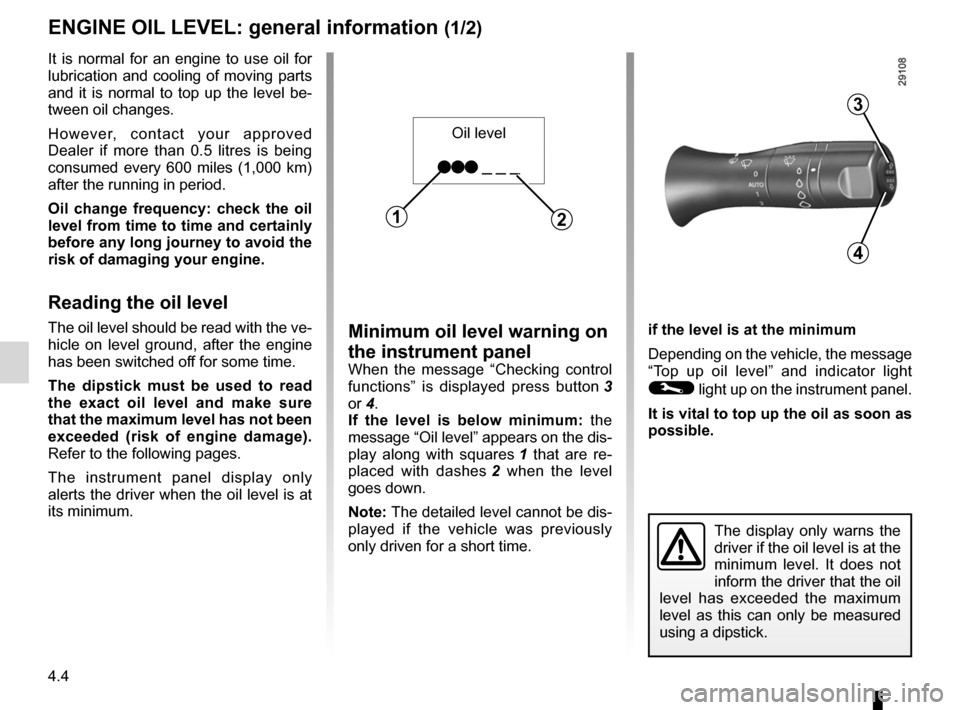
engine oil .............................................. (up to the end of the DU)
oil change ............................................. (up to the end of the DU)
engine oil level ...................................... (up to the end of the DU)
4.4
ENG_UD24022_3
Niveau huile moteur : généralités (L38 - X38 - Renault)
ENG_NU_891_892-7_L38-B32_Renault_4
Jaune NoirNoir texte
Oil level
Engine oil level:
general information
engine Oil level: general information (1/2)
Minimum oil level warning on
the instrument panel
When the message “ Checking control
functions ” is displayed press button 3
or 4.
i f the level is below minimum: the
message “Oil level” appears on the dis-
play along with squares 1 that are re -
placed with dashes 2 when the level
goes down.
note: The detailed level cannot be dis-
played if the vehicle was previously
only driven for a short time. if the level is at the minimum
Depending on the vehicle, the message
“
Top up oil level ” and indicator light
© light up on the instrument panel.
it is vital to top up the oil as soon as
possible.
The display only warns the
driver if the oil level is at the
minimum level. It does not
inform the driver that the oil
level has exceeded the maximum
level as this can only be measured
using a dipstick.
It is normal for an engine to use oil for
lubrication and cooling of moving parts
and it is normal to top up the level be-
tween oil changes.
However, contact your approved
Dealer if more than 0.5 litres is being
consumed every 600 miles (1,000 km)
after the running in period.
Oil change frequency: check the oil
level from time to time and certainly
before any long journey to avoid the
risk of damaging your engine.
Reading the oil level
The oil level should be read with the ve-
hicle on level ground, after the engine
has been switched off for some time.
t he dipstick must be used to read
the exact oil level and make sure
that the maximum level has not been
exceeded (risk of engine damage).
Refer to the following pages.
The instrument panel display only
alerts the driver when the oil level is at
its minimum.
3
4
21